| |
 |
 |
 |
|
 |
 |
 |
 |
 |

|
 |
 |
| |
 |
Researchers
Uncover Extreme Lake -- and 3000-Year-Old
Microbes -- in Mars-Like Antarctic Environment |
 |
| |
 NSF-supported
researchers drilling into Lake Vida, an
Antarctic "ice-block" lake, have found
the lake isn't really an ice block at
all. In the December 16 issue of the Proceedings
of the National Academy of Sciences, the
team reveals that Antarctic Lake Vida
may represent a previously unknown ecosystem,
a frigid, "ice-sealed," lake that contains
the thickest non-glacial lake ice cover
on Earth and water seven times saltier
than seawater. Because of the arid, chilled
environment in which it resides, scientists
believe the lake may be an important template
for the search for evidence of ancient
microbial life on Mars and other icy worlds. NSF-supported
researchers drilling into Lake Vida, an
Antarctic "ice-block" lake, have found
the lake isn't really an ice block at
all. In the December 16 issue of the Proceedings
of the National Academy of Sciences, the
team reveals that Antarctic Lake Vida
may represent a previously unknown ecosystem,
a frigid, "ice-sealed," lake that contains
the thickest non-glacial lake ice cover
on Earth and water seven times saltier
than seawater. Because of the arid, chilled
environment in which it resides, scientists
believe the lake may be an important template
for the search for evidence of ancient
microbial life on Mars and other icy worlds.
Photo credit: Priscu Research Group, Montana
State University at Bozeman
Read
the full story. ... posted
12/16/02
|
 |
Scientists
Use South Pole Telescope to Produce the
Most Detailed Images of the Early Universe |
 |
| |
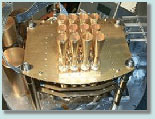 Using
a powerful new instrument at the South
Pole, a team of cosmologists has produced
the most detailed images of the early
Universe ever recorded. The research team,
which was funded by the National Science
Foundation (NSF), has made public their
measurements of subtle temperature differences
in the Cosmic Microwave Background (CMB)
radiation. The CMB is the remnant radiation
that escaped from the rapidly cooling
Universe about 400,000 years after the
Big Bang. Images of the CMB provide researchers
with a snapshot of the Universe in its
infancy, and can be used to place strong
constraints on its constituents and structure.
The new results provide additional evidence
to support the currently favored model
of the Universe in which 30 percent of
all energy is a strange form of dark matter
that doesn't interact with light and 65
percent is in an even stranger form of
dark energy that appears to be causing
the expansion of the Universe to accelerate.
Only the remaining five percent of the
energy in the Universe takes the form
of familiar matter like that which makes
up planets and stars. Using
a powerful new instrument at the South
Pole, a team of cosmologists has produced
the most detailed images of the early
Universe ever recorded. The research team,
which was funded by the National Science
Foundation (NSF), has made public their
measurements of subtle temperature differences
in the Cosmic Microwave Background (CMB)
radiation. The CMB is the remnant radiation
that escaped from the rapidly cooling
Universe about 400,000 years after the
Big Bang. Images of the CMB provide researchers
with a snapshot of the Universe in its
infancy, and can be used to place strong
constraints on its constituents and structure.
The new results provide additional evidence
to support the currently favored model
of the Universe in which 30 percent of
all energy is a strange form of dark matter
that doesn't interact with light and 65
percent is in an even stranger form of
dark energy that appears to be causing
the expansion of the Universe to accelerate.
Only the remaining five percent of the
energy in the Universe takes the form
of familiar matter like that which makes
up planets and stars.
Photo credit: ACBAR, U.C. Berkeley, and
Case Western Reserve University
Read
the full story. ... posted
12/16/02
|
 |
Increases
in Rainfall Variability Related to Global
Climate Change Alter Productivity and
Plant Community Composition |
 |
| |
 Projected
increases in rainfall variability resulting
from changes in global climate can rapidly
reduce productivity and alter the composition
of grassland plants, according to scientists
funded by the National Science Foundation.
Although the diversity of plant species
is increased in this scenario, the most
important or dominant grasses were more
water-stressed and their growth was reduced.
Carbon dioxide release by roots and microbes
below ground also was reduced. Results
of the experiment, conducted at NSF's
Konza Prairie Long Term Ecological Research
(LTER) site, are published in the December
13th issue of the journal Science. Projected
increases in rainfall variability resulting
from changes in global climate can rapidly
reduce productivity and alter the composition
of grassland plants, according to scientists
funded by the National Science Foundation.
Although the diversity of plant species
is increased in this scenario, the most
important or dominant grasses were more
water-stressed and their growth was reduced.
Carbon dioxide release by roots and microbes
below ground also was reduced. Results
of the experiment, conducted at NSF's
Konza Prairie Long Term Ecological Research
(LTER) site, are published in the December
13th issue of the journal Science.
Photo credit: Kansas State University
Read
the full story. ... posted
12/13/02
|
 |
NSF
Hosts Conference on Latest Discoveries
in Nanoscale Science and Technology |
 |
| |
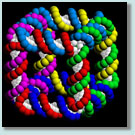 Recipients
of Nanoscale Science and Engineering awards
made in 2001 will highlight initial results
from over 100 NSF-funded projects at a
grantees conference December 11-13, 2002,
at the National Science Foundation. Topics
include: biological models for nanoengineering,
quantum dots and their applications, nanostructured
materials, single molecule transport and
devices, nanoscale electronics, molecular
self-assembly, environmental nanoprocesses,
nanomechanical devices, and national nanotechnology
research and education networks. Recipients
of Nanoscale Science and Engineering awards
made in 2001 will highlight initial results
from over 100 NSF-funded projects at a
grantees conference December 11-13, 2002,
at the National Science Foundation. Topics
include: biological models for nanoengineering,
quantum dots and their applications, nanostructured
materials, single molecule transport and
devices, nanoscale electronics, molecular
self-assembly, environmental nanoprocesses,
nanomechanical devices, and national nanotechnology
research and education networks.
Image courtesy: Dr. Nadrian Seeman, Department
of Chemistry, New York University.
Read
the media advisory. ... posted
12/10/02
Read
about the image and view other nano images.
Additional
conference information.
|
 |
Scientists
Find Earliest "New World" Writings
in Mexico |
 |
| |
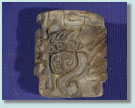 Scientists
have uncovered evidence of what is believed
to be the earliest form of writing ever
found in the New World. The discovery
was based on glyphs carved on a cylindrical
seal used to make imprints, and on greenstone
plaque fragments found near La Venta in
Tabasco, Mexico in the Gulf Coast region.
The writings were produced during the
Olmec era, a pre-Mayan civilization, and
are estimated to date from 650 B.C. Mary
E.D. Pohl of Florida State University,
Kevin O. Pope of Geo Eco Arc Research,
and Christopher von Nagy of Tulane University
describe the findings in the Dec. 6 edition
of Science. Pohl's research was
funded primarily by the National Science
Foundation. Scientists
have uncovered evidence of what is believed
to be the earliest form of writing ever
found in the New World. The discovery
was based on glyphs carved on a cylindrical
seal used to make imprints, and on greenstone
plaque fragments found near La Venta in
Tabasco, Mexico in the Gulf Coast region.
The writings were produced during the
Olmec era, a pre-Mayan civilization, and
are estimated to date from 650 B.C. Mary
E.D. Pohl of Florida State University,
Kevin O. Pope of Geo Eco Arc Research,
and Christopher von Nagy of Tulane University
describe the findings in the Dec. 6 edition
of Science. Pohl's research was
funded primarily by the National Science
Foundation.
Photo Credit: Christopher von Nagy
Read
the full story. ... posted
12/6/02
|
 |
New
NSF Awards Encourage Collaborations Between
Ocean Scientists and Educators |
 |
| |
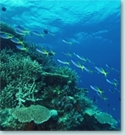 The
National Science Foundation (NSF) has
awarded its first eight grants in a new
Centers for Ocean Science Education Excellence
(COSEE) program designed to integrate
ocean science research into delivery of
high-quality education programs in the
ocean sciences. The new program also aims
to promote a deeper public understanding
of the oceans and their influence on quality
of life and national prosperity. Seven
centers around the country will be formed,
with one central coordinating COSEE office.
Centers are headquartered at: the New
England Aquarium, Boston; University of
California at Berkeley; University of
Southern California; Rutgers University,
New Jersey; University of South Florida;
University of Southern Mississippi; and
the South Carolina Sea Grant Consortium.
The Consortium for Oceanographic Research
and Education (CORE) in Washington, D.C.
will serve as the coordinating network
office. The
National Science Foundation (NSF) has
awarded its first eight grants in a new
Centers for Ocean Science Education Excellence
(COSEE) program designed to integrate
ocean science research into delivery of
high-quality education programs in the
ocean sciences. The new program also aims
to promote a deeper public understanding
of the oceans and their influence on quality
of life and national prosperity. Seven
centers around the country will be formed,
with one central coordinating COSEE office.
Centers are headquartered at: the New
England Aquarium, Boston; University of
California at Berkeley; University of
Southern California; Rutgers University,
New Jersey; University of South Florida;
University of Southern Mississippi; and
the South Carolina Sea Grant Consortium.
The Consortium for Oceanographic Research
and Education (CORE) in Washington, D.C.
will serve as the coordinating network
office.
Read
the full story. ... posted
12/3/02
|
 |
Plant-Fungal
Symbiosis Found in High-Heat Extreme Environment |
 |
| |
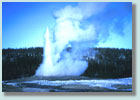 Researchers
examining plants growing in the geothermal
soils of Yellowstone National Park and
Lassen Volcanic National Park have found
evidence of symbiosis between fungi and
plants that may hold clues to how plants
adapt to and tolerate extreme environments.
The research was funded in part through
NSF's Microbial Observatories Program
and published in the Nov. 22 issue of
the journal Science. Biologists
Regina Redman of the University of Washington
and Joan Henson of Montana State University
and their colleagues examined 200 samples
of Dichanthelium lanuginosum,
also called "Geyser's Dichanthelium,"
for fungal colonization. They found what
may be a new species of the fungus Curvularia
that survives only in temperatures greater
than 98 degrees when it associates with
plants. Researchers
examining plants growing in the geothermal
soils of Yellowstone National Park and
Lassen Volcanic National Park have found
evidence of symbiosis between fungi and
plants that may hold clues to how plants
adapt to and tolerate extreme environments.
The research was funded in part through
NSF's Microbial Observatories Program
and published in the Nov. 22 issue of
the journal Science. Biologists
Regina Redman of the University of Washington
and Joan Henson of Montana State University
and their colleagues examined 200 samples
of Dichanthelium lanuginosum,
also called "Geyser's Dichanthelium,"
for fungal colonization. They found what
may be a new species of the fungus Curvularia
that survives only in temperatures greater
than 98 degrees when it associates with
plants.
Image credit: NPS Photo
Read
the full story. ... posted
12/2/02
|
 |
U.S.
Researchers May Provide Entrée
into Coenzyme Q10 Market |
 |
| |
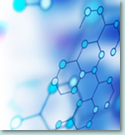 Proponents
of Coenzyme Q10 describe it
as a "miracle nutrient" because of its
potential to invigorate our cells, fight
a variety of diseases, and perhaps even
slow the aging process. However, U.S.
production of the supplement has been
stalled by the lack of an economical synthesis
method to compete with patented techniques
Japanese companies use. Now, U.S. manufacturers
may soon gain a foothold into the international
CoQ10 market. In his laboratory
at the University of California, Santa
Barbara, NSF-sponsored chemist Bruce Lipshutz
and his colleagues have found a successful
way to economically synthesize the compound. Proponents
of Coenzyme Q10 describe it
as a "miracle nutrient" because of its
potential to invigorate our cells, fight
a variety of diseases, and perhaps even
slow the aging process. However, U.S.
production of the supplement has been
stalled by the lack of an economical synthesis
method to compete with patented techniques
Japanese companies use. Now, U.S. manufacturers
may soon gain a foothold into the international
CoQ10 market. In his laboratory
at the University of California, Santa
Barbara, NSF-sponsored chemist Bruce Lipshutz
and his colleagues have found a successful
way to economically synthesize the compound.
Read
the full story ... and other news
tips, including "A Dim View of a Black
Hole" and "Increasing Nitrogen in Earth's
Soils May Signal Global Changes." ...
posted 12/2/02
|
 Top
of Page Top
of Page
|
|
|
 |
 |
 |
 |
 |
 |
 |
 |
|
 |
 |
 |
|
|
| |
|
|
| |
 |
National Science Foundation
Office of Legislative and Public Affairs
4201 Wilson Boulevard
Arlington, Virginia 22230, USA
Tel: 703-292-8070
FIRS: 800-877-8339 | TDD: 703-292-5090
|
 |
|
|
|

